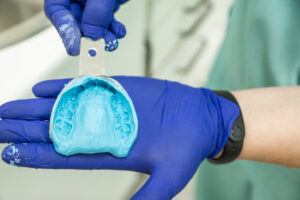Careful and considered finishing can take the outcome of an Invisalign case from good to great. It’s worth spending time on the last few steps of each patient’s aligner journey to ensure your cases are finished to the highest possible standard.
Removing Attachments
One of the things that can let cases down is residual composite left on the teeth from not removing attachments correctly. Over time these stain and look unsightly, they can also feel rough on the patient’s tongue. Some tips for removing attachments are:
- Allow yourself plenty of time to remove attachments as it can take longer than you expect! Magnification and good lighting are essential to make sure you’re not damaging the tooth underneath.
- Dry the teeth thoroughly to make the composite more obvious and chalky, the use of an Optragate makes the task easier.
- Use a UV torch or light to check for any residual composite. These can be bought from Amazon, they are really helpful to have in your surgery.
- Have a selection of burs and discs and see what works best for you – composite debonding burs, soflex discs, enhance wheels and points, and hand scalers can also be useful for small flecks of composite. You will probably use a combination.
- Have a follow-up review appointment to double-check you’ve successfully removed all composite.
Whitening
Studies have shown that colour is the thing that most people notice about a smile, more so than alignment! Home whitening is a simple and effective way to enhance the final result you’ve achieved with aligners. You could give the patient whitening gel to use in their last few aligners, the teeth will whiten under the attachments so you won’t be left with obvious patches once you debond the attachments, but the patient may need to do a few nights top-up to get a perfect blend.
Alternatively, you could make whitening trays after debonding, from your final scan or impressions. It is best not to do a full course of whitening in retainers as the gel can make the retainers more brittle.
Enameloplasty
Enameloplasty, or cosmetic contouring, is the process of removing small amounts of enamel to improve the size, shape or length of a tooth. Any sharp edges, mamelons, or minor differences in incisal edge position can be improved with an enameloplaty which can make such a big difference in the out come of your case.
Soflex discs are great for this and make sure you polish the area well with the whole sequence of discs. The patient should be aware before starting Invisalign that ortho makes teeth straight not necessarily beautiful and some tweaks to tooth shape and size may be needed at the end. This conversation should be had BEFORE the patient starts their ortho, so the need for an enameloplasty or other restorative work, and the associated costs, should not come as a surprise at the end of treatment.
Composite Bonding
Ortho makes teeth straight, not necessarily beautiful, especially when it comes to adults who may have chipped and worn incisal edges. Often composite can be a simple and cost-effective way to take the smile from good to great. Hopefully, you will have spotted at your initial assessment that the patient may benefit from bonding so it won’t be a surprise to them at the end of the aligners.
After isolation (ideally using a rubber dam), heating your composite can really help ensure a smooth application. PTFE between the teeth is less bulky than plastic mylar strips and works well for edge bonding. If you can use a composite system that has enamel and dentine shades the result will look more natural and instruments such as optrasculpt and goat hair brushes are fantastic for ensuring a seamless margin between the composite and the tooth. When polishing your composite, take care to add in anatomy that matches the natural teeth. This can be done using high-speed burs in an electric handpiece using a low RPM, and even rosehead burs very lightly skimming the surface to create perikymata. A final gloss can be achieved with discs – soflex, ASAP wheels, Optragloss etc.
Retainers
Dual retention is recommended where possible to reduce the risk of relapse. A fixed retainer can be placed directly using Ortho-Flextech wire, or they can be lab-made and bonded with the aid of a stent. You can then take your final scan or impression for removable retainers. Always show the patient how to clean around the fixed retainer.
It is possible to trim the last set of aligners with scissors to remove the palatal/lingual aspect where the bonded retainer is to allow the patient to continue wearing the aligners until the removable retainers arrive.
Consider asking your patients to wear their removable retainers day and night like their aligners for the first 6 months, then moving to nightly wear for as long as they would like their teeth to be straight (Forever!).
Final Photos
Taking a full set of photos at the end of treatment is important for your records and documentation of the case to ensure you schedule time in your review appointment to take these. Photos are a great way to celebrate with the patient when you review their smile transformation and before and after photos are an invaluable way to show other patients what you can do. Ensure you have a signed photography consent form from each patient that outlines where and how you will be using the photos.
And finally – don’t forget to ask your patient for referrals and online reviews! If they have had a positive Invisalign journey and are happy with the outcome, asking them for a review or if they have any friends/family who may be interested is a great way to increase the amount of aligner treatment you are doing.
Article by Lydia Sharples





